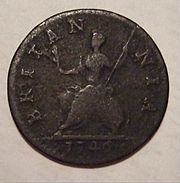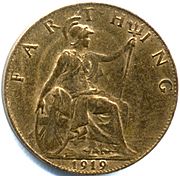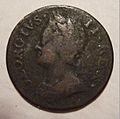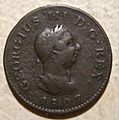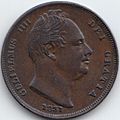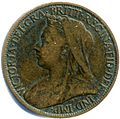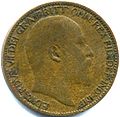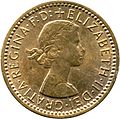Farthing (British coin) facts for kids
| United Kingdom | |
| Value | 14d sterling |
|---|---|
| Mass | 2.83 g |
| Diameter | 20.19 mm |
| Thickness | 0.666 mm |
| Edge | Plain |
| Composition | Bronze |
| Years of minting | 1860–1956 |
| Obverse | |
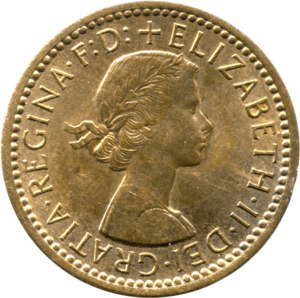 |
|
| Design | Elizabeth II |
| Designer | Mary Gillick |
| Design date | 1953 |
| Reverse | |
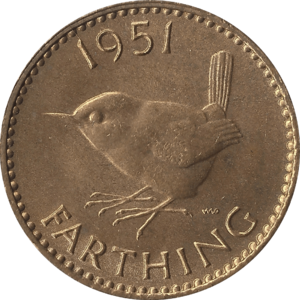 |
|
| Design | Wren (Britannia on earlier mintages) |
| Designer | Harold Wilson Parker |
| Design date | 1937 |
The British farthing was a small coin used in the United Kingdom. Its name, "farthing," comes from an old English word meaning "a fourth." This coin was worth 14 of a penny. To give you an idea, there were 4 farthings in a penny, 48 farthings in a shilling, and 960 farthings in a pound!
The farthing was made from copper at first, and later from bronze. It was used for a very long time, from 1717 until 1956. It was a legal coin during the reigns of eleven British kings and queens, from George I to Elizabeth II.
The farthing stopped being legal money in Britain and Northern Ireland on January 1, 1961. However, it was still used in places like the Falkland Islands until October 31, 1970.
Over its long history, the farthing had two main designs on its back (called the reverse side). For many years, it showed the figure of Britannia, a symbol of Britain. Later, from 1937, it featured a tiny wren bird. Like all British coins, the front (obverse side) of the farthing always showed the portrait of the king or queen who was ruling at the time.
Contents
The Farthing's Journey Through Time
The British copper farthing came into use after England and Scotland joined to form the Kingdom of Great Britain in 1707. Before this, there were English farthings. At first, new farthings weren't made much because there were still plenty of old ones around.
Some British copper farthings were made during the reigns of George I and George II. By the time George III became king in 1760, many fake coins were being used. Because of this, the Royal Mint, which makes coins, stopped making copper coins in 1775.
The next farthings were special because they were the first to be made using steam power! This happened in 1799, thanks to a man named Matthew Boulton. The Royal Mint started making farthings again in 1821. These newer farthings looked a lot like smaller versions of the penny.
Before Britain switched to decimal money in 1971, prices were written differently. For example, "three shillings and six pence" was written as 3/6d. If something cost less than a shilling, it was just written in pence, like 8d.
When a farthing was involved, it was written like this: 214d. This was said as "twopence farthing." Or, 1/314 would be "one and threepence farthing." Sometimes, prices were set just under a whole pound, like 19/1134, which was "nineteen and eleven three farthings." This was similar to how shops today might price something at £0.99 to make it seem cheaper than £1.
Bronze Farthings and New Designs
The first bronze farthings were made in 1860, during the reign of Queen Victoria. These coins had a new design on the back (reverse side). It showed Britannia sitting down, holding a trident (a three-pronged spear). The word "FARTHING" was written above her.
Between 1860 and 1895, there was a small lighthouse on Britannia's left and a ship on her right. Over the years, small changes were made to the sea around Britannia and the angle of her trident. Some coins had jagged edges, while others had small beads around the rim.
Seven different designs were used on the front (obverse side) of the farthing after 1860. Each monarch, like Edward VII, George V, George VI, and Elizabeth II, had their own portrait on the farthings made during their time. Queen Victoria, who ruled for a very long time, had two different portraits.
The farthing from 1860 showed Queen Victoria with her hair in a "bun" or a "draped bust." The words around her portrait were in Latin: "VICTORIA D G BRITT REG F D." This meant "Victoria by the grace of God queen of Britain defender of the faith." In 1895, a new portrait called the "old head" or "veiled bust" was used. The Latin words on these coins were longer: "VICTORIA DEI GRA BRITT REGINA FID DEF IND IMP," which meant "Victoria by the grace of God queen of Britain defender of the faith empress of India."
Farthings made during the reign of Edward VII showed his face. The Latin words on his coins were "EDWARDVS VII DEI GRA BRITT OMN REX FID DEF IND IMP." This meant "Edward VII by the grace of God king of all Britons defender of the faith emperor of India." Similarly, George V's farthings showed his likeness with the Latin words "GEORGIVS V DEI GRA BRITT OMN REX FID DEF IND IMP."
The Wren Farthing
There is a very rare farthing from King Edward VIII's reign (1936), dated 1937. However, it was only a "pattern coin." This means it was made for official approval, but the king gave up his throne before it could be officially released. So, no farthings with his face were ever put into circulation. This pattern coin was unusual because it showed the king's portrait facing left, which broke a tradition of alternating the direction the monarch faces on coins. Some people thought this was a sign of bad luck.
One important feature of Edward VIII's pattern farthing was a new design on the back: a wren, one of Britain's smallest birds. This lovely bird design was then used on all regular farthings from 1937, during the reign of George VI, and continued into the 1950s for Elizabeth II's farthings.
George VI's coins had the Latin words "GEORGIVS VI D G BR OMN REX F D IND IMP" before 1949. After that, the words changed slightly to "GEORGIVS VI D G BR OMN REX FIDEI DEF." Farthings were made throughout the early reign of Elizabeth II. Her coins from 1953 had the words "ELIZABETH II DEI GRA BRITT OMN REGINA F D." Later, they changed to "ELIZABETH II DEI GRATIA REGINA F D."
Faces on the Coins
See also


